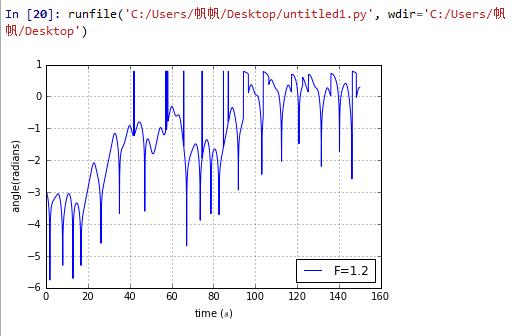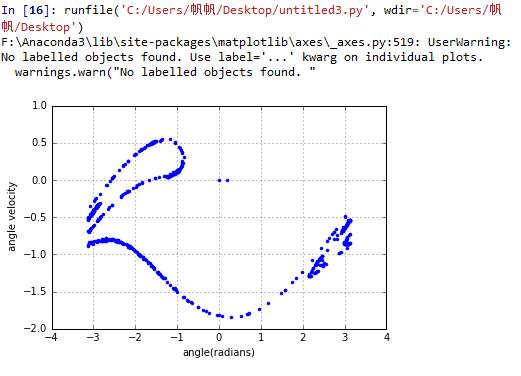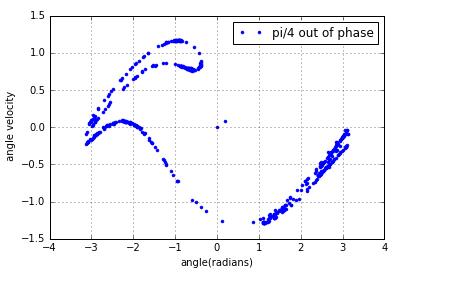@wudawufanfan
2016-10-30T13:18:04.000000Z
字数 5922
阅读 594
Chaos pendulum
pendulum angle-difference driving-force Poincare-section
Abstration
Chaos is a natural but complex phenomenon around the world.Around 100 years ago,French physicist Poincaré found that the Determinism of Newtonian Mechanics was not clear when investigating three-body problem.That means the initial condition will lead to a uncertain result which means chaos.The famous example is The Butterfly Effect.
Text
Now that we have a numerical method that is suitable for various versions of the simple pendulum problem, and armed with some understanding of what might happen, an external driving force and nonlinearity.In general, we have the equation of motion
Firstly,we use Euler method to figure out the problem.We set initial condition same except driving force
import mathimport pylab as plclass harmonic:def __init__(self, w_0 = 0, theta_0=0.2, time_constant = 1, time_of_duration = 20, time_step = 0.04,g=9.8,length=1,q=1,F=5,D=2):# unit of time is secondself.n_uranium_A = [w_0]self.n_uranium_B = [theta_0]self.t = [0]self.g=gself.length=lengthself.dt = time_stepself.time = time_of_durationself.nsteps = int(time_of_duration // time_step + 1)self.q=qself.F=Fself.D=Ddef calculate(self):for i in range(self.nsteps):tmpA = self.n_uranium_A[i] -((self.g/self.length)*math.sin(self.n_uranium_B[i])+1*self.n_uranium_A[i]-self.F*math.sin(self.D*self.t[i]))*self.dttmpB = self.n_uranium_B[i] + self.n_uranium_A[i]*self.dtself.n_uranium_A.append(tmpA)self.n_uranium_B.append(tmpB)self.t.append(self.t[i] + self.dt)def show_results(self):pl.plot(self.t, self.n_uranium_B,label=' F=5')pl.xlabel('time ($s$)')pl.ylabel('angle(radians)')pl.legend(loc='best',frameon = True)pl.grid(True)a = harmonic()a.calculate()a.show_results()class diff_check(harmonic):def show_results2(self,style='b'):pl.plot(self.t, self.n_uranium_B,style,label=' F=10')pl.xlabel('time ($s$)')pl.ylabel('angle(radians)')pl.legend(loc='best',frameon = True)pl.grid(True)b=diff_check(w_0 = 0, theta_0=0.2, time_constant = 1, time_of_duration = 20, time_step = 0.04,g=9.8,length=1,q=1,F=10,D=2)b.calculate()b.show_results2('r')

chapter3.12、3.13
problem3.13 ask us to find with time under the force
import mathimport pylab as plclass harmonic:def __init__(self, w_0 = 0, theta_01=0.2,theta_02=0.2+0.001, time_of_duration = 400, time_step = 0.04,g=9.8,length=9.8,q=1/2,F=1.2,D=2/3):# unit of time is secondself.n_uranium_A1 = [w_0]self.n_uranium_B1= [theta_01]self.n_uranium_A2 = [w_0]self.n_uranium_B2= [theta_02]self.a=[math.log(abs(theta_02-theta_01))]self.t = [0]self.g=gself.length=lengthself.dt = time_stepself.time = time_of_durationself.nsteps = int(time_of_duration // time_step + 1)self.q=qself.F=Fself.D=Ddef calculate(self):for i in range(self.nsteps):self.n_uranium_A1.append(self.n_uranium_A1[i] -((self.g/self.length)*math.sin(self.n_uranium_B1[i])+self.q*self.n_uranium_A1[i]-self.F*math.sin(self.D*self.t[i]))*self.dt)self.n_uranium_B1.append(self.n_uranium_B1[i] + self.n_uranium_A1[i+1]*self.dt)if self.n_uranium_B1[i+1]<-math.pi:self.n_uranium_B1[i+1]=self.n_uranium_B1[i+1]+2*math.piif self.n_uranium_B1[i+1]>math.pi:self.n_uranium_B1[i+1]=self.n_uranium_B1[i+1]-2*math.pielse:passself.n_uranium_A2.append(self.n_uranium_A2[i] -((self.g/self.length)*math.sin(self.n_uranium_B2[i])+self.q*self.n_uranium_A2[i]-self.F*math.sin(self.D*self.t[i]))*self.dt)self.n_uranium_B2.append(self.n_uranium_B2[i] + self.n_uranium_A2[i+1]*self.dt)if self.n_uranium_B2[i+1]<-math.pi:self.n_uranium_B2[i+1]=self.n_uranium_B2[i+1]+2*math.piif self.n_uranium_B2[i+1]>math.pi:self.n_uranium_B2[i+1]=self.n_uranium_B2[i+1]-2*math.pielse:passself.t.append(self.t[i] + self.dt)self.a.append(math.log(abs(self.n_uranium_B2[i+1]-self.n_uranium_B1[i+1])))def show_results(self):pl.plot(self.t, self.a)pl.xlabel('time ($s$)')pl.ylabel(' angle(radians)')pl.legend(loc='upper right',frameon = True)pl.grid(True)pl.show()a = harmonic()a.calculate()a.show_results()

change the force to 0.5

we can say
for ,pick two top points like(13.7903,-4.52358) and (39.3145,-7.32757) to calculate
for ,pick two top points like(14.5161,-3.33464) and (60.3226,-0.362945) to calculate
Poincare section
we plot versus only at times that are in phase with driving force,that is,dispaly the point when
import mathimport pylab as plclass harmonic:def __init__(self, w_0 = 0, theta_0=0.2, time_of_duration = 10000, time_step = 0.04,g=9.8,length=9.8,q=1/2,F=1.2,D=2/3):# unit of time is secondself.n_uranium_A = [w_0]self.n_uranium_B = [theta_0]self.t = [0]self.g=gself.length=lengthself.dt = time_stepself.time = time_of_durationself.nsteps = int(time_of_duration // time_step + 1)self.q=qself.F=Fself.D=Dself.n_uranium_A2=[0]self.n_uranium_B2=[0]def calculate(self):for i in range(self.nsteps):self.n_uranium_A.append(self.n_uranium_A[i] -((self.g/self.length)*math.sin(self.n_uranium_B[i])+self.q*self.n_uranium_A[i]-self.F*math.sin(self.D*self.t[i]))*self.dt)self.n_uranium_B.append(self.n_uranium_B[i] + self.n_uranium_A[i+1]*self.dt)if self.n_uranium_B[i+1]<-math.pi:self.n_uranium_B[i+1]=self.n_uranium_B[i+1]+2*math.piif self.n_uranium_B[i+1]>math.pi:self.n_uranium_B[i+1]=self.n_uranium_B[i+1]-2*math.pielse:passself.t.append(self.t[i] + self.dt)for i in range(self.nsteps):if self.t[i]%(2*math.pi/self.D)<0.02:self.n_uranium_A2.append(self.n_uranium_A[i])self.n_uranium_B2.append(self.n_uranium_B[i])def show_results(self):pl.plot( self.n_uranium_B2,self.n_uranium_A2,'.')pl.xlabel('angle(radians)')pl.ylabel(' angle velocity')pl.legend(loc='upper right',frameon = True)pl.grid(True)pl.show()a = harmonic()a.calculate()a.show_results()

problem 3.12 ask us to change phase by
so,I change the condition as followings
if (self.t[i]-math.pi/4)%(2*math.pi/self.D)<0.02:

we can see two figures are apparent with a little difference.
the overall figure rises compared with figure3.9 in the textbook.
Thanks
the people who discuss this problem with me
